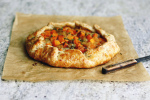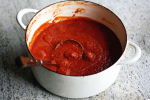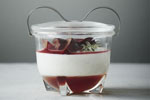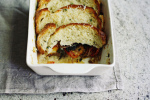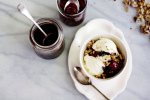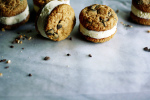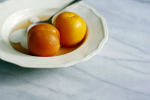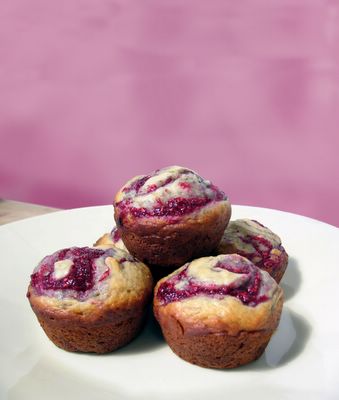À la mode
 Wednesday, June 1, 2005 at 9:24PM
Wednesday, June 1, 2005 at 9:24PM 
There has always been the need to eat; but somewhere along the way we discovered the notion of eating fashionably.
One of my greatest pleasures in my older cookbooks is to see the evolution of tastes through their pages. As Donna Hay put it in her book Modern Classics, Book 1, “What macaroni and cheese was to me, risotto will be to the children of today when they come adults doing the cooking in the future.” I find that idea fascinating; the way that foods, like any cultural phenomenon, move from innovation to trend, ending up in either the fad or classics category. We’ve all watched cuisines, techniques and specific flavours move in and out of the limelight.
The three books pictured in my inaugural post were all ones stolen from my Mother’s collection. Spanning 32 years, these publications chronicle an amazingly rapid progression of tastes, all promoting the au courant menus of the moment.
The oldest, The Ogilvie Cook Book (Ogilvie Flours Mills Co., Limited, 10th edition, revised 1957) promotes itself as “a liked and respected friend of our modern homemakers.” Truly the must-have guide to home entertaining, it includes Appetizer Rolls made with Velveeta Cheese, undiluted condensed soup, bacon and Parker House rolls; Extra Good Homemade Chili with cayenne, salt and pepper as the only seasonings; and Half Moon Bay Crabs served in homemade tin foil faux crab shells. Italian food is still an emerging cuisine for the North American household, while German specialties are mainstays and French cuisine is chic. Aspic and jellies figure heavily into multiple chapters.
I realize I sound tounge-in-cheek, but my interest in these recipes is sincere – the attention to detail and specificity of garnishes show evident care and a belief in these dishes. And though these may not be staples in my current repertoire, I respect what they represent to the homemakers of 50 years ago.
These mini cheesecakes are far from revolutionary. Simplicity itself, without much accoutrement or fuss – a soft vanilla centre topped with tart berries, presented in a crumbly crust. I remember when cheesecakes were all the rage when I was little – I am pretty sure I remember the first cheesecake I’d ever tried, one brought from New York by a favourite uncle. And though the humble cake may now be prominent on most chain-restaurant menus (and in the name of one chain in particular), in my opinion, its allure has not diminished.
My idea of a classic cheesecake
An amalgamation of recipes
Crust
1/4 cup butter, melted
1 1/4 cups graham wafer crumbs
Filling
24 ounces cream cheese (three packages), at room temperature
1 cup granulated sugar
3 eggs
1 tablespoon lemon zest (optional)
2 teaspoon vanilla
Pinch of salt (up to 1/2 teaspoon)
1 cup sour cream
Fresh berries, chocolate or sauces to garnish
Preheat oven to 180°C (350°F).
Lightly butter bottom and sides of a 91/2-inch springform pan. In a small bowl, stir crumbs with butter until mixed. Press onto bottom of pan. Bake in centre of preheated oven until set, about 8 to 10 minutes. Cool completely. Leave oven on.
Meanwhile, using a stand or handheld mixer beat cream cheese until smooth and creamy. Slowly add sugar and cornstarch, beating well combined, scraping down sides of bowl as needed. Add eggs one at a time, beating after each addition until incorporated. Beat in lemon juice, vanilla and salt. Add sour cream and stir just until mixed.
Wrap the underside and halfway up the sides of the springform pan with a double layer of heavy-duty foil. Pour cream cheese mixture into pan. Set pan in a larger ovenproof dish. Fill larger dish or roasting pan with enough hot water to come about 1 inch up the sides of pan. Do not fill water higher than where the foil comes up the side. Bake in centre of preheated oven. After 45 minutes the cheesecake will not be completely set; keep the door shut to the oven and turn it off. Allow the cheesecake to rest in the cooling oven for about one hour.
Remove pan from water and discard foil. Run a thin knife around outside edge of cheesecake to release it from the pan. Cool in pan on a baking rack at room temperature for one hour. Refrigerate for at least three hours, preferably overnight. Garnish with fresh berries, chocolate, whipped cream or however desired.
Cheesecake will keep well refrigerated for several days or can be frozen.
Notes
• To make the mini version as pictured, use standard 24 x 1/2 cup capacity muffin tins. Double the graham cracker crust amounts and divide mixture between the tins. Bake for only 4-5 minutes to set. Ladle cheesecake mixture into each muffin tin, until about 2/3 full. Bake in a Bain Marie for about 12 minutes, or until just set (the sides will be dry, the centre still quite moist). Follow cooling directions as listed above. After chilling, invert cakes onto a baking sheet, then carefully transfer to plates. Garnish and serve.
• If garnishing with chocolate, sweetened whipped cream or a particularly sweet fruit, I sometimes cut the sugar down to 3/4 cup.
 baking,
baking,  cheesecake,
cheesecake,  dessert,
dessert,  recipe,
recipe,  sweet
sweet 

